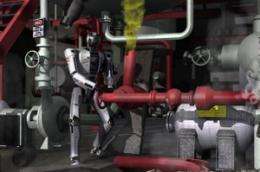Developing a robot that can go where humans fear to tread

It sounds like a science fiction scenario: a nuclear reactor is racing toward meltdown, and someone needs to close a valve to stop cooling water from leaking out of the reactor. Unfortunately, radiation levels near the valve would be fatal to a human being. The solution: send in a humanoid robot that can drive to the reactor, clamber over debris, climb a ladder, break through some concrete, locate the valve, and crank it closed.
Sometime in the next three years, a robot may successfully achieve a mission very much like that one to win a $2 million prize through the DARPA (Defense Advanced Research Projects Agency) Robotics Challenge, which was officially kicked off on Oct. 24. WPI is part of one of seven "A teams" selected by DARPA to develop humanoid robots to compete in the challenge; each has received an award of up to $3 million from DARA to fund the work.
The team to which WPI will contribute expertise is led by Paul Oh at Drexel University and includes researchers from Columbia University, the University of Delaware, Georgia Tech, Indiana University, Ohio State, Purdue, Swarthmore, and the Korea Advanced Institute of Science and Technology.
"This is the most exciting humanoid robotics project ever undertaken in the United States," notes Dmitry Berenson, assistant professor of computer science and robotics engineering, who will lead WPI's research group. Berenson notes that the DARPA challenge is intended to spur the development of advanced technologies that can enable human-like robots to execute complex tasks in human-engineered environments and to work where it is too risky to send people.
"Other countries have made advances in this area," he says, "but there has been resistance to humanoid robots here, partly for cultural reasons and partly because they are very difficult to work with. But humanoid robots can be useful in many scenarios, everything from helping elderly people live in their own homes to responding to disasters, so it is exciting to see DARPA investing in the research foundation for this field."
Different university teams are working on the eight tasks outlined in the DARPA proposal. WPI will tackle Task 7: locate and close a valve near a leaking pipe. "This task requires a lot of difficult work," Berenson says. "First, the robot has to locate the right valve. Then it has to determine where to stand, which for humans is intuitive because we can draw on millions of years of evolution and decades of experience. But for a robot this is a very difficult problem because there are all sorts of reachability and balance issues. Finally, it needs to turn the valve, which is also a complex task."
The WPI group will bring several areas of expertise to bear on this task. Berenson's work in motion planning algorithms, which help robots plan out complex actions, will play a critical role throughout the activity. Sonia Chernova, assistant professor of computer science and robotics engineering, will apply her expertise in machine learning and learning from demonstration to the challenge of teaching the robot how to execute the required activities. Rob Lindeman, associate professor of computer science, will draw on his knowledge of virtual reality and novel computer interfaces to develop an interface people can use to give the robot high-level guidance.
In the months ahead, the multi-university team will be developing its robot systems, first in simulations, then with a Korean humanoid robot called HUBO. This will be a prelude to complicated series of elimination events pitting against one another a host of university and private teams, some funded by DARPA, others self-funded, culminating, perhaps, with one $2 million winner.
Berenson says the challenge ahead is huge, but the opportunity to advance humanoid robotics research makes it worthwhile. "This is an amazing competition," he says. "Whatever happens, I feel very lucky to be a part of it."
Provided by Worcester Polytechnic Institute


















